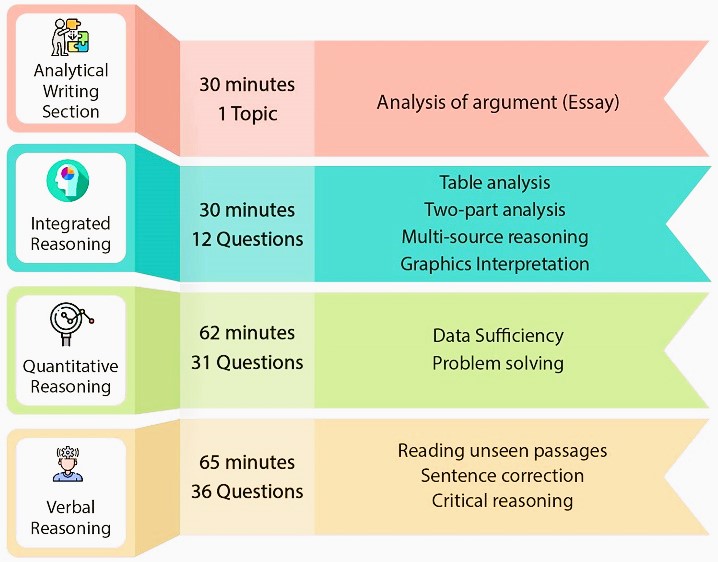What is the GMAT?
The Graduate Management Admission Test, or GMAT, is an important part of the business school application process. The GMAT is a multiple-choice, computer-based, standardized exam, which uses standard written English and basic mathematics to test the quantitative and verbal skills of prospective business school applicants. The GMAT is required for admission to most MBA, MIM, and business-oriented MSc as well as PhD programs globally. Although some programs do not require you to submit GMAT results, providing them is considered an advantage and therefore actively encouraged.
The GMAT is developed and administered by test-maker GMAC to provide business schools with a common measure of applicants’ readiness for the rigors of graduate-level academic work. Business school admission committees assess GMAT scores, together with work experience, academic records, and other individual supporting materials, to be able to select between qualified applicants.
The usefulness of the GMAT does not stop at academics though. Several employers, especially top consulting, finance, and banking firms, consider GMAT scores as a reliable measure of job applicants’ analytical skills. In some cases, the GMAT is accepted instead of company specific aptitude tests.
How does the GMAT work?
The GMAT contains four sections:
Analytical Writing Assessment
- Number of Questions: 1 essay prompt
- Task: Analysis of an argument
- Time: 30 minutes
- Score: 0 to 6
The Analytical Writing Assessment (AWA), or essay section, of the GMAT is designed to measure your ability to think critically and communicate ideas effectively in writing. It consists of one essay prompt, which presents an argument that you are expected to objectively analyze and critique within the 30-minute time limit. You will be evaluated on how well you analyze the argument, find its flaws, organize your thoughts, and convey your ideas in writing.
Essays are evaluated by a human reader and a grading software system. The resulting final score is reported on a scale of 0 to 6, in half-point increments. The AWA section does not affect the overall score of the GMAT, which ranges from 200 to 800. However, it is an important supplementary part of your application to business schools, especially if you are applying as a non-native English speaker.
Integrated Reasoning
- Number of questions: 12 multi-part questions
- Task: Use arithmetic, basic statistics, text comprehension and logic to answer Multi-Source Reasoning, Table Analysis, Graphics Interpretation and Two-Part Analysis questions.
- Time: 30 minutes
- Score: 1 to 8
The Integrated Reasoning (IR) section of the GMAT relies on both quantitative and verbal subjects to test your ability to understand, sort, analyze and interpret graphs, tables, charts and texts. In contrast with the Quant section of the exam, which tests your ability to solve with limited data provided, IR is designed to test your ability to deal with large and complex sources of data. The IR section is divided into four types of questions: Multi-Source Reasoning, Table Analysis, Graphics Interpretation and Two-Part Analysis.
– In Multi-Source Reasoning you are presented with several tabs of information, which you must effectively combine in order to answer several multiple-choice or true/false questions.
– In Table Analysis you are given a multi-column and multi-row table, which you must sort in order to select the appropriate data in order to answer several true/false questions.
– In Graphics Interpretation you are presented with a visual data representation, such as a pie chart, bar graph, scatter plot or similar, which you must understand and interpret in order to answer several fill-in-the-blanks questions.
– In Two-Part Analysis you are given either a quantitative or verbal data source, and asked to answer two interdependent multiple-choice questions about it.
The IR section is scored from 1 to 8. The IR section does not affect the overall score of the GMAT, which ranges from 200 to 800. There are plans to include the IR, alongside the Quantitative and Verbal sections, in the scored part of the exam in the next major revision of the GMAT.
Quantitative Reasoning
- Number of questions: 31 multiple-choice problems
- Time: 62 minutes
- Task: Use arithmetic, algebra, statistics and geometry skills to answer Problem Solving and Data Sufficiency questions.
- Score range: 6 to 51
The Quantitative Reasoning (Quant) section of the GMAT uses basic math subjects such as arithmetic, algebra, statistics and geometry to measure your quantitative reasoning, data analysis and pattern recognition skills. The Quantitative section is divided into two types of questions: Problem Solving and Data Sufficiency.
– In Problem Solving questions you are given a problem and five answer options to choose from. In most questions you are expected to solve the problem and then select the corresponding answer option, although some questions require other methodologies such as crossing-out answer options, plugging-in numbers, or even estimating.
– In Data Sufficiency questions, you are presented with a problem and two statements that provide additional data. To answer correctly you need to determine whether the information in the statements is sufficient to solve the problem or not. For most questions you are not required to solve the problem all the way through, as knowing that you are able to is enough. Some problems though require you to find a specific solution before you are able to answer.
The Quant section of the exam is scored from 6 to 51 and accounts for half of your total GMAT score, which, after being adjusted, ranges from 200 to 800.
Verbal Reasoning
- Number of questions: 36 multiple-choice questions
- Task: Use reading, vocabulary and grammar skills in standard written English to answer Reading Comprehension, Critical Reasoning and Sentence Correction questions.
- Time: 65 minutes
- Score: 6 to 51
The Verbal Reasoning (Verbal) section of the GMAT utilizes your understanding of standard written English to test your reading, vocabulary and grammar skills, as well as your ability to combine common knowledge with logic in order to analyze information and arguments. The Verbal section is divided into three types of questions: Reading Comprehension, Critical Reasoning and Sentence Correction.
– In Reading Comprehension you are presented with a published academic text on business or science, and will be asked 3 to 4 questions on that text while still being able to view it. In order to answer the questions, you will need to both understand the main idea and purpose of the passage, while also keeping track of the detailed information presented in the text.
– In Critical Reasoning you are given a short text describing an argument, plan or circumstance. You are then asked to determine an assumption or conclusion, to strengthen or weaken an argument, to evaluate a plan, or to resolve a discrepancy. To find the right answer you must make use of logic and common knowledge to identify and correctly evaluate the underlying cause-and-effect relationships.
– In Sentence Correction you are given a complicated, often convoluted or even obscure, sentence with part, or all of it, underlined and then asked to select one out of the five given versions of that underlined section. Four out of the five options, including the original, include one or several mistakes. In order to select the correct answer, you have to make use of your knowledge of grammar and idioms, and also consider the intended meaning of the sentence.
The Verbal section of the exam is scored from 6 to 51 and accounts for half of your total GMAT score, which, after being adjusted, ranges from 200 to 800.


